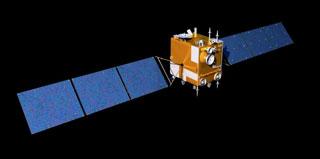
An artistic representation of Chang'e 2 satellite.
BEIJING (PTI): China's second Moon orbiter Chang'e-2, on a drift in outer space after completing its lunar mission, has travelled 1.5 million km away from Earth and is orbiting second Lagrange Point (L2), where gravity from the Sun and Earth balances orbital motion of a satellite.
Chang'e-2 entered L2's orbit last Thursday after spending 77 days travelling away from its previous orbital path around the Moon, the State Administration of Science, Technology and Industry for National Defence (SASTIND) said on Tuesday.
The SASTIND said that China is now the world's third country or organisation to successfully put a spacecraft into orbit around L2, after the European Space Agency (ESA) and the National Aeronautics and Space Administration (NASA) of US.
The Chang'e-2 will carry out exploration activities around L2 in the coming year, SASTIND said, according to official Xinhua news agency.
There are five "Lagrange Points" about 1.5 million km away from the Earth in the exact opposite direction from the Sun.
Putting a spacecraft at any of these points allows it to stay in a fixed position relative to the Earth and Sun with a minimal amount of energy needed for course correction.
The orbiter completed all of its assigned tasks after blasting off on October 1 last year, according to the SASTIND.
Although the orbiter was only supposed to remain in space for six months, the SASTIND decided to assign additional tasks to it, as it still had fuel in its reserve tanks.
Travelling into outer space from the Moon's orbit was one of the orbiter's most important missions, SASTIND said.
Before arriving at its current position in outer space, the Chang'e-2 took photos of the northern and southern poles of the moon. It then descended to a lower orbit, approximately 15 km away from the moon's surface, where it captured high-resolution images of the Sinus Iridum, or "Bay of Rainbows," an area where future moon probes may land.
The SASTIND is reportedly planning to launch measure and control stations into outer space by the end of the second half of next year. The Chang'e-2 will be used to test the two stations' functionality at that time.
China's ambitious three-stage moon mission will include a moon landing, as well as the launch of a moon rover during the second stage, which is scheduled to take place in 2012.
During the third phase, another rover will land on the moon and return to Earth with lunar soil and stone samples for scientific research around 2017.
China does not currently have a timetable in place for a manned moon landing. It launched its first lunar probe, the Chang'e-1, in October 2007.
In 2003, China became the third country after Russia and US to send a human into space. Two more manned space missions followed, the most recent of which took place in 2008.













The Indian Air Force, in its flight trials evaluation report submitted before the Defence Ministry l..
view articleAn insight into the Medium Multi-Role Combat Aircraft competition...
view articleSky enthusiasts can now spot the International Space Station (ISS) commanded by Indian-American astr..
view article